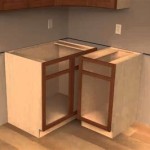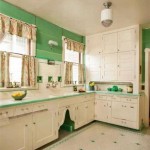Is Blue a Good Color for a Kitchen?
Blue, a color often associated with tranquility and peace, has become an increasingly popular choice for kitchen design. Its versatility, ranging from pale sky blues to deep navy hues, allows for a wide range of aesthetic possibilities. However, the suitability of blue for a kitchen depends on several factors, including the size of the space, the amount of natural light, and the desired overall ambiance.
One of the primary benefits of using blue in a kitchen is its calming effect. This can create a serene atmosphere conducive to cooking and socializing. Lighter blues, such as robin's egg or powder blue, can make a small kitchen feel more spacious and airy. These shades reflect light well, creating an illusion of larger dimensions. They also pair well with white or cream cabinetry and countertops, further enhancing the sense of brightness.
Darker blues, such as navy or royal blue, can add a touch of drama and sophistication to a larger kitchen. These shades can be used on cabinetry, walls, or as accent colors on islands or backsplashes. They create a sense of depth and richness, particularly when contrasted with lighter elements like stainless steel appliances or light-colored countertops. However, in smaller kitchens, darker blues can feel overwhelming and make the space appear smaller than it is.
The amount of natural light in the kitchen plays a crucial role in determining the effectiveness of blue. Kitchens with ample natural light can handle a wider range of blue hues, from the palest to the deepest. The natural light prevents the space from feeling too dark or closed in, even with deeper shades. In contrast, kitchens with limited natural light benefit from lighter blues that reflect light and maintain a sense of airiness. Darker blues in these spaces can create a gloomy atmosphere.
The style of the kitchen also influences the suitability of blue. In traditional kitchens, softer blues can complement classic design elements like white Shaker cabinets and farmhouse sinks. These shades create a timeless and elegant look. In modern kitchens, bolder blues can be used to create a sleek and contemporary feel. These shades pair well with minimalist design elements and stainless steel appliances.
Beyond aesthetics, blue is also believed to have an appetite-suppressing effect. While scientific evidence is limited, some studies suggest that blue can reduce hunger and promote healthier eating habits. This makes it a potentially beneficial color choice for those looking to maintain a healthy lifestyle. However, individual responses to color vary, and the impact of blue on appetite should not be considered a definitive factor in kitchen design.
When incorporating blue into a kitchen, it's important to consider the undertones of the chosen shade. Blue can have warm or cool undertones, which can significantly affect the overall feel of the space. Warm blues, with hints of green or gray, can create a more inviting and relaxed atmosphere. Cool blues, with hints of purple or violet, can feel more crisp and refreshing.
The chosen finish of the blue elements also plays a role. Matte finishes can create a more subtle and understated look, while glossy finishes can add a touch of glamour and reflect light more effectively. The texture of the surfaces can also influence the perception of the color. For example, a textured blue backsplash can add depth and visual interest compared to a smooth, flat surface.
Complementary color pairings are essential for creating a balanced and harmonious kitchen design. Blue pairs well with a variety of colors, including white, cream, gray, and even warmer tones like yellow or orange. White and cream create a classic and timeless look with blue, while gray adds a touch of sophistication. Yellow and orange provide a vibrant contrast and can create a cheerful and energetic atmosphere.
Careful consideration should be given to the specific shade of blue and its placement within the kitchen. Accenting with blue through accessories like dish towels, artwork, and small appliances allows for flexibility and experimentation without a full commitment. This approach allows homeowners to assess the impact of blue in their kitchen before incorporating it into larger design elements.
Ultimately, the decision of whether blue is a good color for a kitchen is a matter of personal preference and depends on various factors specific to the individual space and desired aesthetic. Careful consideration of these factors, along with thoughtful planning and execution, can result in a beautiful and functional blue kitchen that meets the homeowner's needs and reflects their personal style.

10 Beautiful Blue Kitchen Decorating Ideas Best Paints For Your

10 Beautiful Blue Kitchen Decorating Ideas Best Paints For Your

Blue Kitchen Ideas For Your Home Designcafe

20 Blue Kitchen Cabinet Ideas Light And Dark Paint Colors

Best Kitchens In Classic Blue Try Out The Trendiest Color Many Tones Decoist

15 Kitchens In Blue The Latest Color Trend Kitchen Design

The 6 Best Kitchen Paint Color Trends We Love For 2024

How To Choose The Right Paint Colors For Your Kitchen

Navy Blue Kitchen Home Bunch Interior Design Ideas

65 Blue Kitchen Cabinet Ideas For Your Decorating Inspiration Interiorzine
Related Posts








